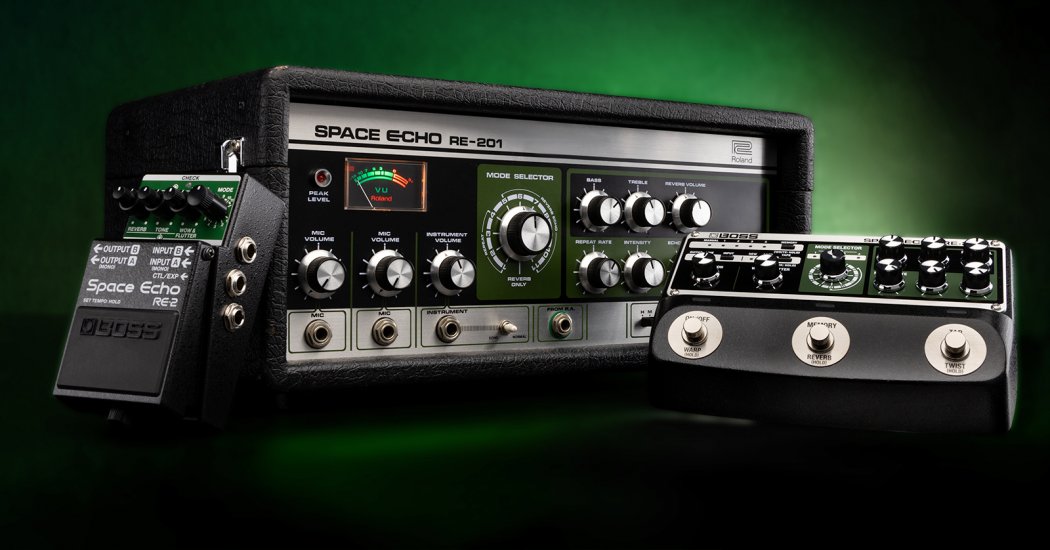
Our industry has seen countless tape delays come and go, but few have remained as iconic as the Roland Space Echo. This seminal hardware effect has been highlighted beautifully on classic Pink Floyd and David Bowie albums, and it’s an essential ingredient in the dub stylings of artists like Osbourne “King Tubby” Ruddock and Lee “Scratch” Perry. Whether you desire subtle tape textures or you’re looking to drown yourself in an endless wave of chaotic ambience, the Space Echo is the right tool for the job. In this article, we’ll revisit the history of the Roland Space Echo and discuss the most recent iterations of this esteemed piece of gear.
Generation One: The Cartridge Era
The first Roland offerings to bear the Space Echo moniker were the RE-100 and RE-200. Originally produced in 1973, both the RE-100 and RE-200 were tape-based delay units, and the RE-200 incorporated a spring reverb alongside the tape delay. These early Space Echoes, which employed short 1/4-inch tape reels, were rock-solid and reliable, but their innards tended to exhibit a lot of unwanted mechanical noise.
Unlike later Space Echoes, which made use of free-running tape transports, these first-generation models contained Sony RE-series tape cartridges. The reliance on these cartridges was problematic in a number of ways. Not only did this cartridge-based design offer inferior sound quality compared to the later units, but the cartridges were also a hassle to maintain and replace. Moreover, users were at the mercy of a third party to ensure the future feasibility of their units. After all, if Sony were to stop production of the RE tape cartridge (which they eventually did), then their Space Echoes would become high-tech paperweights.
The Legendary Green Echo Machine
In 1974, Roland released the RE-101 and RE-201 Space Echo models. Both were tape-delay units, and, similar to the preceding generation, the RE-201 included a spring reverb. Instead of a noisy reel-based system, however, these new units employed a free-running tape transport system in which the tape spooled freely inside the unit, using a capstan drive protected by a plastic cover.
The RE-201, which was considered Roland’s flagship Space Echo, quickly became a must-have piece of kit for studios and guitarists alike. Not only did it produce addictively ear-grabbing echoes and reverbs, but its free-running tape transport system also avoided the mechanical noise that plagued the earlier cartridge-based units. Beyond that, the RE-201 boasted terrific wow and flutter specs and was highly resistant to wear and tear. To top it off, since the RE-201 wasn’t reliant on reels or cartridges, users were free to use whatever tape they wanted to, which made maintenance a piece of cake.
The RE-150 Space Echo, which was unveiled in 1979, was marketed as an entry-level alternative to the RE-201. The RE-150 brandished two playback heads rather than the RE-201’s three, which limited its sonic flexibility, and it didn’t include the RE-201’s vaunted spring reverb. Furthermore, the RE-150 included dual outputs: one carrying a dry signal and one carrying a wet signal.
The RE-201 is arguably the most famous Space Echo of all time, so much so that it remained in constant production until the early 1990s, even as updated models were released.
The Space Echo’s Chorus-equipped Cousins
Throughout the 1970s and 1980s, Roland continued to release Space Echo variants. In 1977, the RE-301 Chorus Echo entered the fray, bolstering the famous tape-delay sounds of its forerunners with a lush-sounding analog chorus that could be deployed both in tandem with and independently of the delays. You also got a sound-on-sound mode, which was essentially a primitive progenitor of modern-day looping.
In 1982, Roland unleashed two new Chorus Echo models: the RE-501 and the SRE-555. Both of these units contained the same features as the RE-301 but with better noise specs and four playback heads for added sonic versatility. These models also included modern LED metering instead of the traditional VU metering of its predecessors. The RE-501 boasted a similar form factor to the RE-301 but replaced its classic green and silver look with Roland’s then-preferred black and orange color scheme. The SRE-555 took the same components as the RE-501 and packed them into a 19-inch rackmountable chassis.
The RE-501 and SRE-555 were the final tape-based models produced by Roland since, by the early ’80s, the popularity of digital processors had begun to eclipse that of old-school analog units.
Surviving the Digital Age
The early 1980s marked a period of rapid technological evolution, and nothing was more cutting-edge at the time than digital. Seriously, everything went digital — analog appeared to be going the way of the dodo. Roland responded to this trend with 1988’s RE-3 Digital Space Echo. The RE-3 was a 1U-rackspace unit that bore little resemblance to its tape-loaded ancestors either visually or sonically. Nonetheless, it was a state-of-the-art piece of gear with the ability to save and recall presets and churn out dual tap delays up to 300ms. The RE-3 also boasted a digital reverb circuit and a Warmth control designed to emulate the wow and flutter of a tape-based delay.
Released alongside the RE-3, the RE-5 was Roland’s high-end version of the Digital Space Echo with an expanded control set and more robust I/O capabilities. The RE-5 sold very poorly, so it quickly dropped from Roland’s product lineup. Consequently, there aren’t many RE-5 Digital Space Echoes floating around on the used market.
Stomp on a Space Echo
By the time the early aughts arrived, we were in the midst of the pedalboard revolution — guitar racks were pretty much extinct. Roland understood this. So, in 2007, under their BOSS brand, they released the RE-20 Space Echo pedal. The RE-20 packed a digital version of a ’70s-era RE-201 into a double-wide stompbox housing complete with a 12-mode selector knob inspired by the original analog unit as well as modeled wow and flutter and magnetic head saturation. Even better, the RE-20 included tap tempo, longer delay times than the original unit, and expression pedal control. Furthermore, you could plant it on your pedalboard and stomp on it!
The Current Roster of Space Echo Pedals
In 2022, the guitar community was treated to a two-fisted treat: two new Space Echo pedals. The first pedal originally released in 2022 is the full-size BOSS RE-202, and it’s a more-than-worthy successor to the now-discontinued RE-20. It arms you with a spot-on digital re-creation of the sound and feel of a vintage Roland RE-201, yielding multi-head echoes with expanded delay times. You get all the original unit’s echo modes along with an extra, courtesy of a fourth tape head. In addition to a perfectly emulated spring reverb, the RE-202 includes hall, place, room, and ambience settings. You also get tweakable wow and flutter and preamp saturation, the ability to toggle between “new” and “aged” tape, Guitar and Line modes, and creative Warp and Twist footswitch functions. Onboard memory, MIDI implementation, stereo I/O, tap tempo, and carryover features round out the RE-202.
The second pedal that was originally released in 2022 is the BOSS RE-2. Packed into a traditional BOSS stompbox, the RE-2 offers many of the same benefits of the larger RE-202, including a digital re-creation of a vintage Roland RE-201, multi-head tape effects, simulated wow and flutter and preamp saturation, and a mind-bending Twist effect. You also get a gorgeous spring reverb emulation, tap tempo, and a true stereo signal path.
In 2023, we got another pedal inspired by the RE-201, the BOSS BP-1W. This boost/preamp stompbox delivers three dedicated boost effects inspired by vintage BOSS and Roland effects: the CE-1 Chorus Ensemble, an ultra-clean boost, and the RE-201 Space Echo. While the BP-1W doesn’t contain any echo or reverb effects, it does a splendid job of slamming your guitar amp with the warm grit we’d normally associate with the RE-201’s built-in preamp.
Yet another modern pedalboard iteration of the Space Echo is the Universal Audio Galaxy ’74. This stompbox leverages dual-engine processing in tandem with UA’s unrivaled analog modeling to provide you with a wide range of ear-grabbing delay and reverb effects inspired by the Roland RE-201.
A Space Echo for Your DAW
We often think of the Space Echo as a guitar effect; in reality, it was conceived and is frequently deployed as a studio effect on drums, vocals, synths, and guitars alike. Given that the bulk of today’s productions rely on plug-ins rather than outboard hardware, it only makes sense that modern producers have access to a software iteration of the RE-201.
Along with a photorealistic user interface, the Universal Audio UAD Galaxy Tape Echo plug-in offers true-to-life analog tape delay and spring reverb effects that are dead ringers for a Roland RE-201. Galaxy Tape Echo includes adjustable pitch shifting, wow and flutter, and saturation for spot-on realism. You also get plug-in-only features, such as tempo sync, effects panning, and the ability to choose between new, used, and old tape. Bass and treble EQ and a library of outstanding stock presets round out this must-have plug-in.
The Arturia Delay Tape-201 plug-in is another excellent tribute to the Roland RE-201, supplying you with 11 modes with four repeat stages and seven reverb echo stages. The Delay Tape-201 includes Left/Right, Ping-Pong, and Mid-Side modes along with a generous cache of controls for tailoring the intensity, width, and tone of the effect. Flutter, Motor Inertia, and Noise controls enable you to add realistic artifacts to your sound. You also get an LFO module for even more creative fun.
Take a Trip into Outer Space
Are you ready to add psychedelic tape delay and spring reverb goodness to your productions or guitar rig? Trust us. Once you get a taste of what a Space Echo can do for your music, you’ll find yourself reaching for it again and again — you’ll never look back! Give your Sweetwater Sales Engineer a call at (800) 222-4700 today, and we’ll set you up with the best pedal or plug-in (or both) for your needs.


